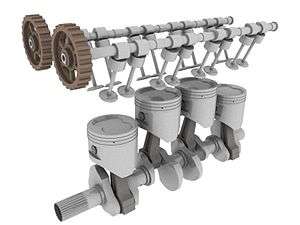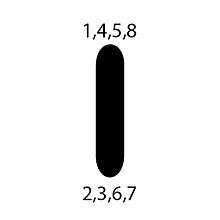Flat-plane crank
The flat-plane crank (sometimes flatplane) is a type of crankshaft for use in internal combustion engines that has a 180 degree angle between crank throws.[1]
Flat-plane cranks are used in V-configuration engines, generally with eight cylinders.[1]

Inline-four cylinder engines almost all use flat-plane cranks, and thus are not usually identified as such. However, there are a few exceptions with crossplane cranks.

The flat-plane crankshaft is a design that is no longer used in most mass production road cars as it is more prone to vibration and is inherently much louder than a crossplane crankshaft. However, due to its simpler construction requiring less counterweight, it is inherently lighter with a higher rev limit. For this reason, it remains useful in sports and racing cars.[1] Flat-plane crankshafts are generally associated with European sports cars such as Ferrari and Lotus V8 engines, and cross-plane cranks with American manufacturers. There are some exceptions such as the Ferrari-designed crossplane crank V8 of the Lancia Thema 8.32 and the flat-plane crank Ford Mustang GT350. [2]
The way in which a flat-plane works within a V8 engine is more like two in-line 4-cylinder engines mated together,[1] with the firing order of each order being in a Right-Left-Right-Left-Right-Left-Right-Left pattern.[3] Being in this in-line configuration allows for the engine to rev much faster, making it more suitable for racing engines.
References
- "What Is A Flat-Plane Crank And Why Is It So Loud?". Retrieved 19 April 2016.
- "Full text of "Motor January 2016"". Retrieved 19 April 2016.
- Clark, John. "Flat Plane Crank". Projectm71. Retrieved 3 May 2019.